Aerodynamic Investigation of Datum and Slotted Blade Profiles under Different Mach Number Conditions
Abstract
:1. Introduction
2. Configurations and Computational Method
2.1. Blade Profile
2.2. Computational Details
3. Mach Number Effects on Performance and Deficit Thickness
3.1. Mach Number Effects on Total Pressure Loss and Loading
3.1.1. Total Pressure Loss
3.1.2. Loading Abilities
3.2. Evolution of Deficit Thickness
3.2.1. Velocity Distribution at the Trailing Edge
3.2.2. Deficit Thickness at the Trailing Edge
4. Effects of Deficit Thickness on Loading
4.1. DF Varying with Momentum Deficit Thickness
4.2. Zweifel Loading Coefficient Varying with Momentum Deficit Thickness
5. The Underlying Loss Mechanism
5.1. Destruction Coefficient
5.2. Dissipation Function
6. Conclusions
- The mass-averaged total pressure loss contours showed that the low loss range for the datum profile reduced sharply with increasing Mach number. The employment of slots alters the low loss operating range towards a positive incidence range and broadens the low loss range in all Mach number conditions tested.
- The DF and Zweifel loading coefficient are compared in evaluating the loading. The reduced Zweifel loading coefficient limits the increase rate of DF, and the slotted profile allows a higher DF to be obtained than the datum profile when the same blade loading is suffered.
- Three kinds of deficit thickness are defined and evaluated for the flow in the profile trailing edge. All the deficit thicknesses in the SS are much higher than that in the PS. The slotted profile contributes to diminishing the accumulated thick boundary layer at the profile trailing edge. As a kind of passive flow control method, it suppresses the separation and improves the performance at positive incidence, and does not deteriorate much in negative incidence.
- The correction of loading to the momentum deficit thickness demonstrates that it is difficult to distinguish failure simply based on the DF values for a given geometry, particularly under high loadings. The Zweifel loading coefficient connects well with the low momentum deficit in the profile trailing edge. V-shaped distributions appear for each Mach number condition in the - plot. Although the drop in Zweifel loading lags behind the increase in momentum deficit, the peak of the V-shape could better suggest the design condition, under which the profile could achieve better performance both in loss and loading ability, and a region near the V-shape peak could better indicate the correct operating range. Additionally, this judgement is not limited by the incidence range and the occurrence of bulk separation under positive incidences.
- The nondimensionalized destruction of mean mechanical energy and dissipation function are employed to analyze the loss mechanism. Either the increased incidence angle or the increased Mach number results in decreased coefficient peak values for the datum profile in the suction surface. Because as a majority part of the destruction of mean mechanical energy, the Reynolds stress that resists the mean flow deformation transforms the mean flow kinetic energy into kinetic energy for turbulence fluctuation, the boundary layer with a lower destruction coefficient has less ability to resist the adverse pressure gradient; thus, the separation occurs more easily for the datum profile under larger incidence or high Mach number conditions. The slotted profile gains the ability of the boundary layer flow near the suction surface to resist the adverse pressure gradient, and the lift off of the high destruction coefficient bound is eliminated. A reduced shear thickness and a uniformed downstream flow field is obtained by the slotted profile.
Author Contributions
Funding
Acknowledgments
Conflicts of Interest
Nomenclature
| chord (m) | |
| nondimensionalized destruction of mean mechanical energy (-) | |
| distance from the wall (m) | |
| local diffusion factor (-) | |
| mean kinetic energy (m2/s2) | |
| pressure (Pa) | |
| strain rate (s−1) | |
| time (s) | |
| velocity (m/s) | |
| Reynolds stress (kg/m∙s2) | |
| characteristic velocity (m/s) | |
| velocity (m/s) | |
| total pressure loss (-) |
| Density (kg/m3) | |
| Zweifel loading coefficient (-) | |
| displacement thickness (-) | |
| momentum deficit thickness (-) | |
| kinetic energy deficit thickness (-) | |
| molecular kinetic viscosity (m2/s) | |
| turbulence kinetic viscosity (m2/s) | |
| nondimensionalized dissipation function (-) |
| stagnation value | |
| inlet value | |
| free stream |
| 2D | two-dimensional |
| 3D | three-dimensional |
| AVDR | axial velocity density ratio |
| CFD | computational fluid dynamic |
| DF | diffusion factor |
| PS | pressure side |
| SS | suction side |
References
- Slotnick, J.P.; Khodadoust, A.; Alonso, J.J.; Darmofal, D.L.; Gropp, W.D.; Lurie, E.A.; Mavriplis, D.J.; Venkatakrishnan, V. Enabling the environmentally clean air transportation of the future: A vision of computational fluid dynamics in 2030. Philos. Trans. R. Soc. A Math. Phys. Eng. Sci. 2014, 372, 20130317. [Google Scholar] [CrossRef]
- Lakshminarasimha, A.N.; Boyce, M.P.; Meher-Homji, C.B. Modeling and analysis of gas turbine performance deterioration. J. Eng. Gas Turbines Power 1994, 116, 46–52. [Google Scholar] [CrossRef]
- Wennerstrom, A.J. Highly loaded axial flow compressors: History and current developments. ASME J. Turbomach. 1990, 112, 567–578. [Google Scholar] [CrossRef]
- Brent, J.A. Single Stage Experimental Evaluation of Compressor Blading with Slots and Vortex Generators, Part III—Data and Performance for Stage 4; NASA CR-72741; NASA Lewis Research Center: Cleveland, OH, USA, 1970.
- Rockenbach, R.W. Single Stage Experimental Evaluation of Slotted Rotor and Stator Blading, Part IX—Final Report; NASA CR-54553; NASA Lewis Research Center: Cleveland, OH, USA, 1968.
- Rockenbach, R.W.; Brent, J.A.; Jones, B.A. Single Stage Experimental Evaluation of Compressor Blading with Slots and Vortex Generators, Part I—Analysis and Design of Stages 4 And 5; NASA CR-72626; NASA Lewis Research Center: Cleveland, OH, USA, 1970.
- Wennerstrom, A.J. Some experiments with a supersonic axial compressor stage. ASME J. Turbomach. 1987, 109, 388–397. [Google Scholar] [CrossRef]
- Brent, J.A.; Clemmons, D.R. Single-Stage Experimental Evaluation of Tandem-Airfoil Rotor and Stator Blading for Compressors, Part VIII—Final Report; NASA CR-134713; NASA Lewis Research Center: Cleveland, OH, USA, 1974.
- Koch, C.C.; Smith, L.H. Experimental Evaluation of Outer Case Blowing or Bleeding of Single Stage Axial Flow Compressors, Part III—Performance of Blowing Insert Configuration No. 1; NASA CR-54589; NASA Lewis Research Center: Cleveland, OH, USA, 1968.
- Koch, C.C.; Smith, L.H. Experimental Evaluation of Outer Case Blowing or Bleeding of Single Stage Axial Flow Compressor, Part IV—Performance of Bleed Insert Configuration No. 3; NASA CR-54590; NASA Lewis Research Center: Cleveland, OH, USA, 1968.
- Gbadebo, S.A.; Cumpsty, N.A.; Hynes, T.P. Control of three-dimensional separation in axial compressor by tailored boundary layer suction. ASME J. Turbomach. 2008, 130, 011004. [Google Scholar] [CrossRef]
- Liu, Y.W.; Sun, J.J.; Lu, L.P. Corner separation control by boundary layer suction applied to a highly loaded axial compressor cascade. Energies 2014, 7, 7994–8007. [Google Scholar] [CrossRef]
- Cao, Z.Y.; Liu, B.; Zhang, T. Control of separations in a highly loaded diffusion cascade by tailored boundary layer suction. Proc. Inst. Mech. Eng. Part C J. Mech. Eng. Sci. 2014, 228, 1363–1374. [Google Scholar] [CrossRef]
- Li, Y.H.; Wu, Y.; Zhou, M. Control of the corner separation in a compressor cascade by steady and unsteady plasma aerodynamic actuation. Exp. Fluid 2010, 48, 1015–1023. [Google Scholar] [CrossRef]
- Akcayoz, E.; Vo, H.D.; Mahallati, A. Controlling corner stall separation with plasma actuators in a compressor cascade. ASME J. Turbomach. 2016, 138, 081008. [Google Scholar] [CrossRef]
- Staats, M.; Nitsche, W. Active control of the corner separation on a highly loaded compressor cascade with periodic nonsteady boundary conditions by means of fluidic actuators. ASME J. Turbomach. 2016, 138, 031004. [Google Scholar] [CrossRef]
- De Giorgi, M.G.; De Luca, C.G.; Ficarella, A.; Marra, F. Comparison between synthetic jets and continuous jets for active flow control: Application on a NACA0015 and a compressor stator cascade. Aerosp. Sci. Technol. 2015, 43, 256–280. [Google Scholar] [CrossRef]
- Evans, S.; Hodson, H.; Hynes, T. Flow control in a compressor cascade at high incidence. J. Propuls. Power 2010, 26, 828–836. [Google Scholar] [CrossRef]
- Chen, C.; Chen, F.; Yu, J.Y. Experimental investigation of endwall VGJs in a compressor cascade. Appl. Therm. Eng. 2018, 145, 386–395. [Google Scholar] [CrossRef]
- Du, J.; Li, Y.W.; Li, Z.H.; Li, J.C.; Wang, Z.N.; Zhang, H.W. Performance enhancement of industrial high loaded gas compressor using Coanda jet flap. Energy 2019, 172, 618–629. [Google Scholar] [CrossRef]
- Hu, J.G.; Wang, R.G.; Li, R.K.; Wu, P.G. Effects of slot jet and its improved approach in a high-load compressor cascade. Exp. Fluids 2017, 58, 155. [Google Scholar] [CrossRef]
- Keerthi, M.C.; Rajeshwaran, M.S.; Kushari, A. Effect of leading-edge tubercles on compressor cascade performance. AIAA J. 2016, 54, 912–923. [Google Scholar] [CrossRef]
- Zhong, J.J.; Han, J.A.; Liu, Y.M.; Tian, F. Numerical Simulation of Endwall Fence on the Secondary Flow in Compressor Cascade. In Proceedings of the ASME Turbo Expo 2008: Power for Land, Sea, and Air, Berlin, Germany, 9–13 June 2008. [Google Scholar]
- Hergt, A.; Meyer, R.; Engel, K. Effects of vortex generator application in the performance of a compressor cascade. ASME J. Turbomach. 2012, 135, 021026. [Google Scholar] [CrossRef]
- Yi, W.L.; Ji, L.C. Experimental investigation in the performance of compressor cascade using blended-blade-end-wall contouring technology. Proc. Inst. Mech. Eng. Part G J. Aerosp. Eng. 2017, 232, 2833–2844. [Google Scholar] [CrossRef]
- Yi, W.L.; Ji, L.C. Control and Entropy Analysis of Corner Flow Separation in a Compressor Cascade Using Streamwise Grooves. Entropy 2019, 21, 928. [Google Scholar] [CrossRef] [Green Version]
- Liu, Y.W.; Sun, J.J.; Tang, Y.M.; Lu, L.P. Effect of slot at blade root on compressor cascade performance under different aerodynamic parameters. Appl. Sci. 2016, 6, 421. [Google Scholar] [CrossRef]
- Sun, J.J.; Liu, Y.W.; Lu, L.P.; Ottavy, X. Control of corner separation by optimized slot configuration in a linear compressor cascade. Compres. Blower Fan Technol. 2016, 6, 9–18. [Google Scholar]
- Tang, Y.M.; Liu, Y.W.; Lu, L.P.; Lu, H.W.; Wang, M. Experimental Investigation of Flow Control Using Blade End Slots in a Highly Loaded Compressor Cascade. In Proceedings of the International Symposium on Transport Phenomena and Dynamics of Rotating Machinery, Maui, HI, USA, 16–21 December 2017. [Google Scholar]
- Tang, Y.M.; Liu, Y.W.; Lu, L.P.; Lu, H.W.; Wang, M. Passive Separation Control with Blade-End Slots in a Highly Loaded Compressor Cascade. AIAA J. 2020, 58, 85–97. [Google Scholar] [CrossRef]
- Tang, Y.M.; Liu, Y.W.; Lu, L.P. Evaluation of compressor blading with blade end slots and full-span slots in a highly loaded compressor cascade. ASME J. Turbomach. 2019, 141, 121002. [Google Scholar] [CrossRef]
- Tang, Y.M.; Liu, Y.W.; Lu, L.P. Solidity effect on corner separation and its control in a high-speed low aspect ratio compressor cascade. Int. J. Mech. Sci. 2018, 142, 304–321. [Google Scholar] [CrossRef]
- Yoon, S.; Ajay, R.; Chaluvadi, V.; Michelassi, V.; Mallina, R. A Passive Flow Control to Mitigate the Corner Separation in an Axial Compressor by a Slotted Rotor Blade. In Proceedings of the ASME Turbo Expo, Phoenix, AZ, USA, 17–21 June 2019. GT2019-90754. [Google Scholar]
- Denton, J.D. Loss mechanisms in turbomachines. ASME J. Turbomach. 1993, 115, 621–656. [Google Scholar] [CrossRef]
- Liu, Y.W.; Yan, H.; Lu, L.P.; Li, Q.S. Investigation of vortical structures and turbulence characteristics in corner separation in a linear compressor cascade using DDES. ASME J. Fluids Eng. 2017, 139, 021107. [Google Scholar] [CrossRef]
- Kan, X.X.; Wang, S.T.; Yang, L.; Zhong, J.J. Vortex dynamic mechanism of curved blade affecting flow loss in compressor cascade during corner stall process. Aerosp. Sci. Technol. 2018, 85, 443–452. [Google Scholar] [CrossRef]
- Goodhand, M.N.; Miller, R.J.; Lung, H.W. The impact of geometric variation on compressor two-dimensional incidence range. ASME J. Turbomach. 2015, 137, 021007. [Google Scholar] [CrossRef]
- Liu, Y.W.; Tang, Y.M.; Tucker, P.G.; Scillitoe, A.D. Modification of shear stress transport turbulence model using helicity for predicting corner separation flow in a linear compressor cascade. ASME J. Turbomach. 2020, 142, 021004. [Google Scholar] [CrossRef]
- Menter, F.R.; Kuntz, M.; Langtry, R. Ten years of industrial experience with the SST turbulence model. Turbul. Heat Mass Transf. 2003, 4, 625–632. [Google Scholar]
- Lieblein, S.; Schwenk, F.C.; Broderick, R.L. Diffusion Factor for Estimating Losses and Limiting Blade Loadings in Axial-Flow-Compressor Blade Elements; Lewis Flight Propulsion Laboratory: Cleveland, OH, USA, 1953.
- Gbadebo, S.A.; Cumpsty, N.A.; Hynes, T.P. Three-dimensional separations in axial compressors. ASME J. Turbomach. 2005, 127, 331–339. [Google Scholar] [CrossRef]
- Wheeler, A.P.S.; Dichens, A.M.J.; Miller, R.J. The effect of nonequilibrium boundary layers on compressor performance. J. Turbomach. 2018, 140, 101003. [Google Scholar] [CrossRef] [Green Version]
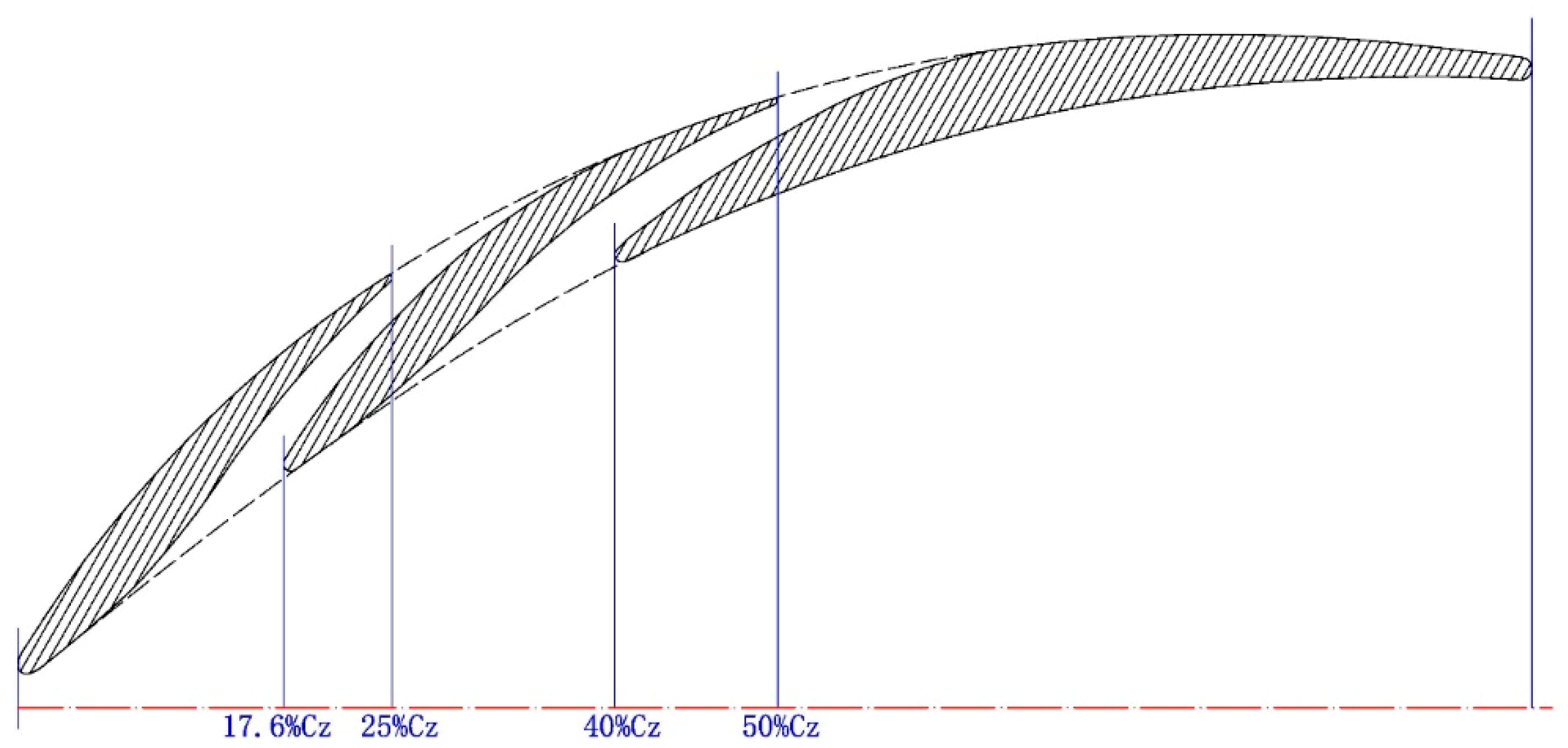

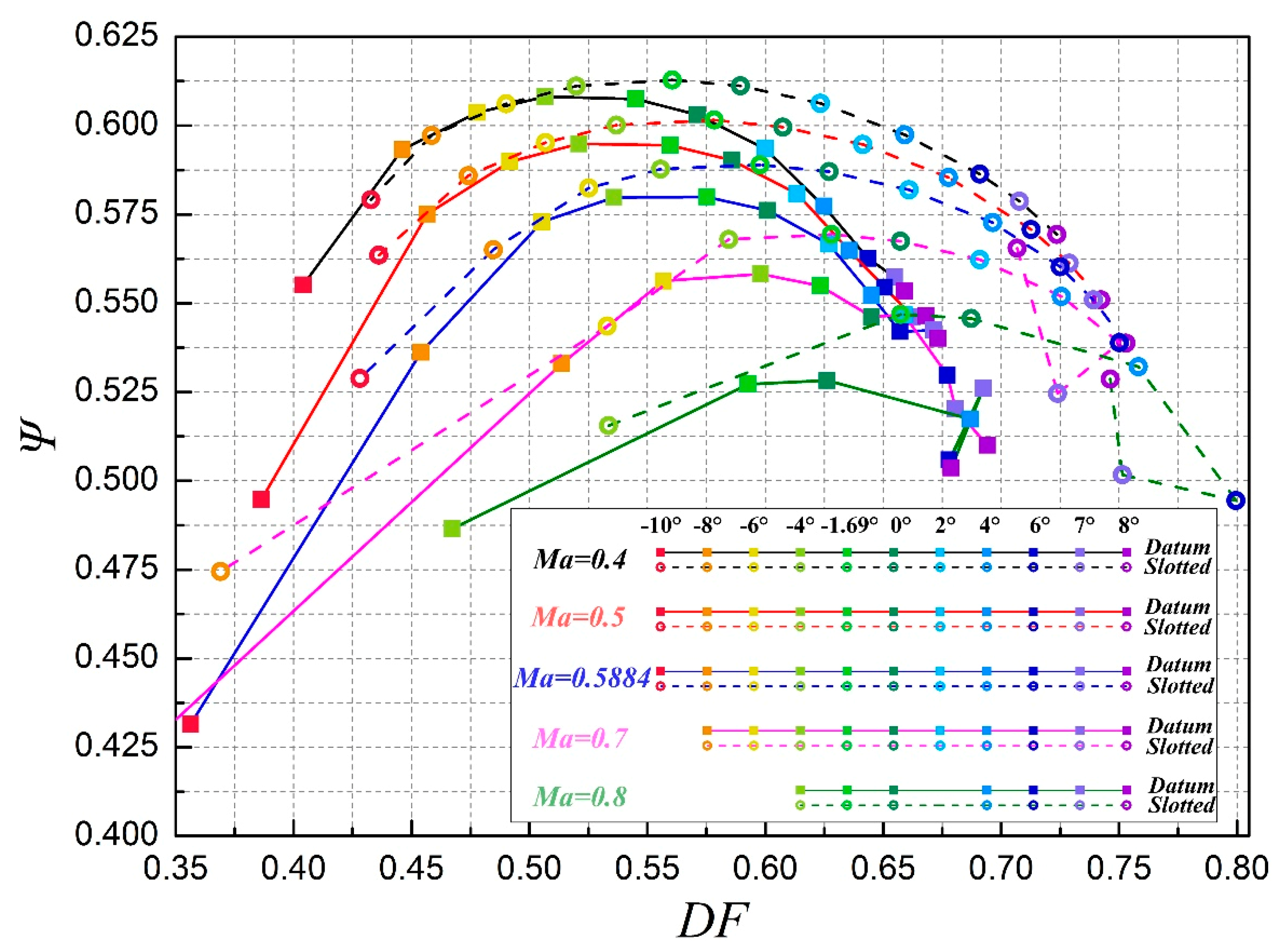
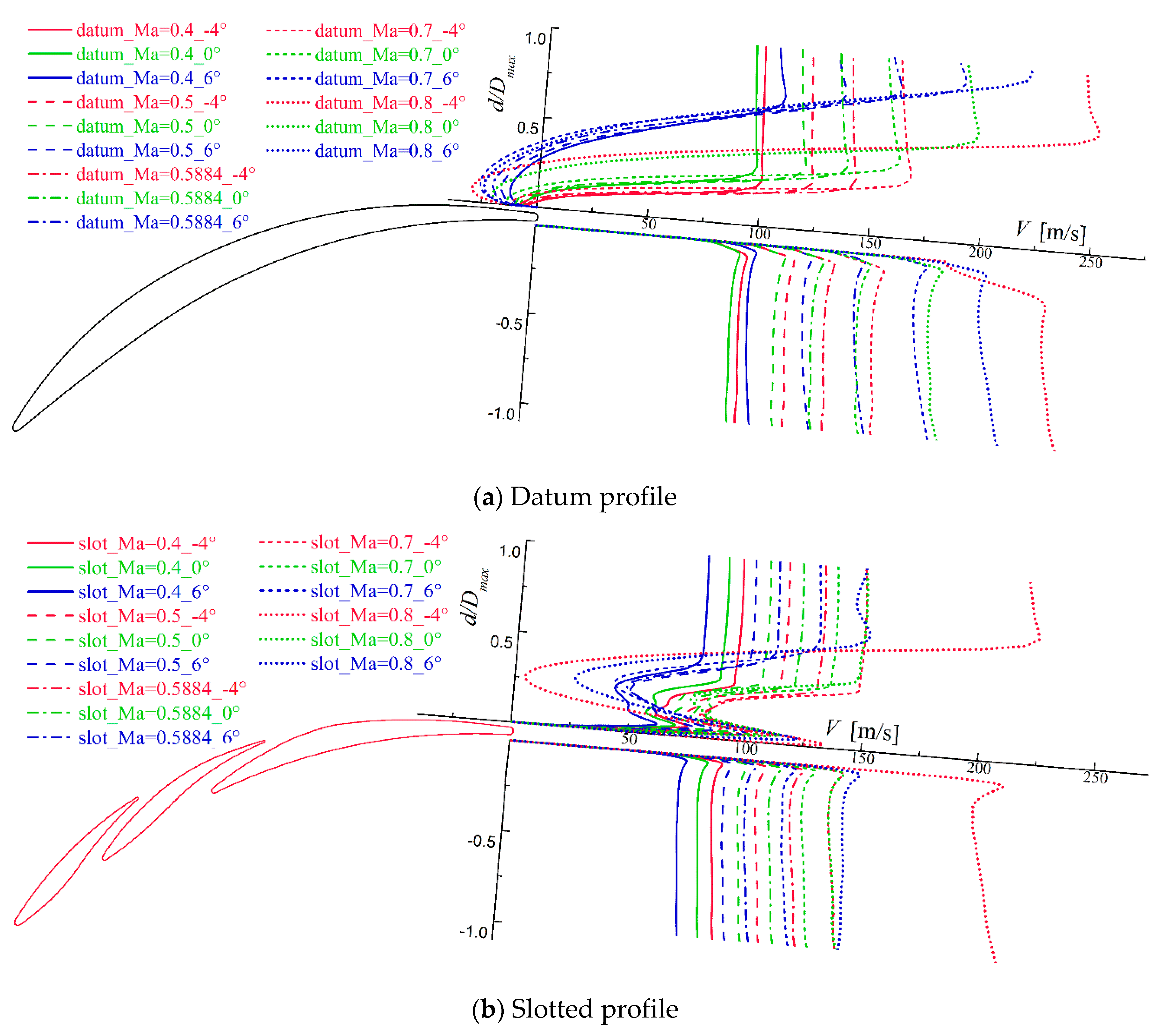
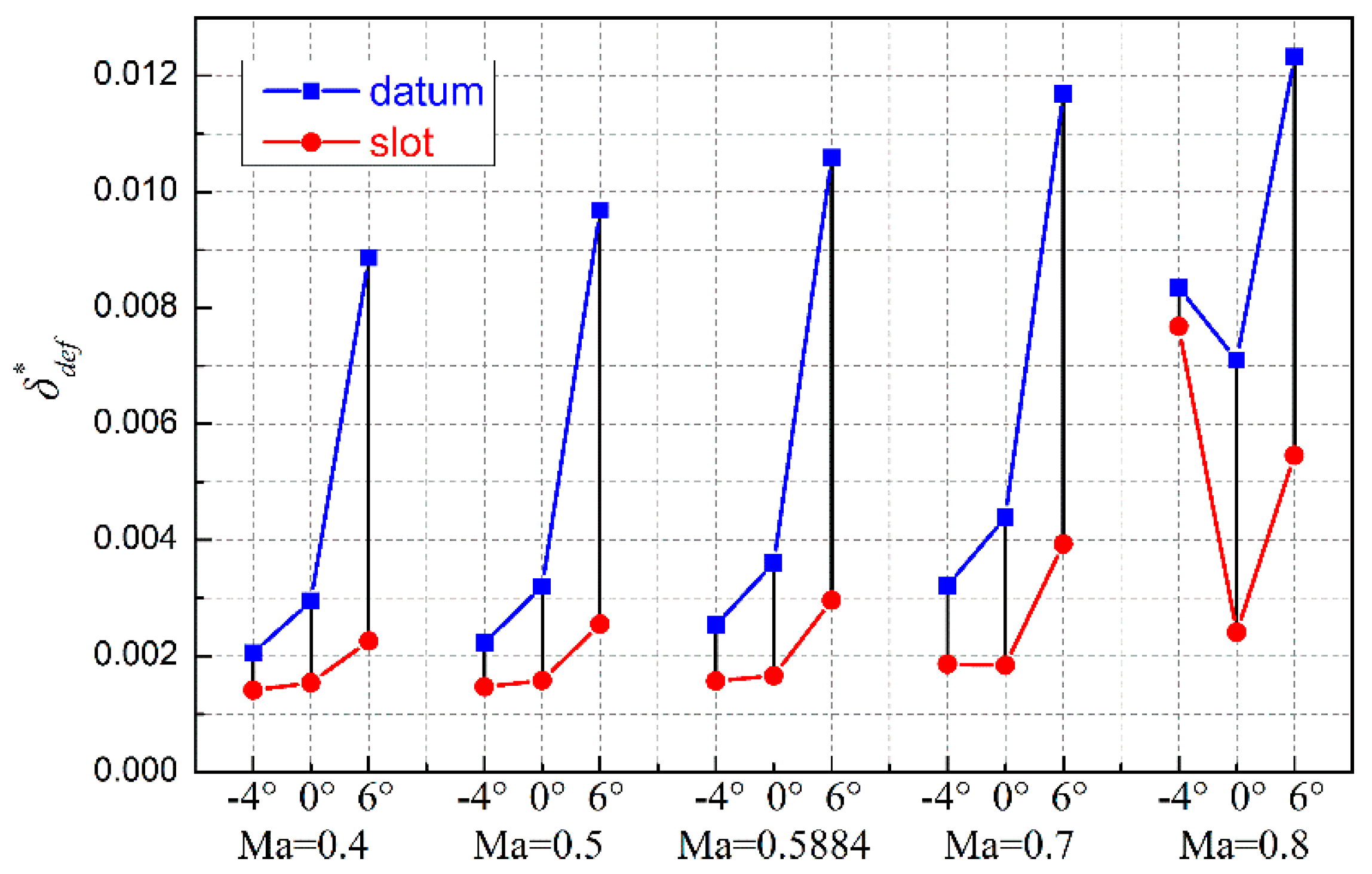
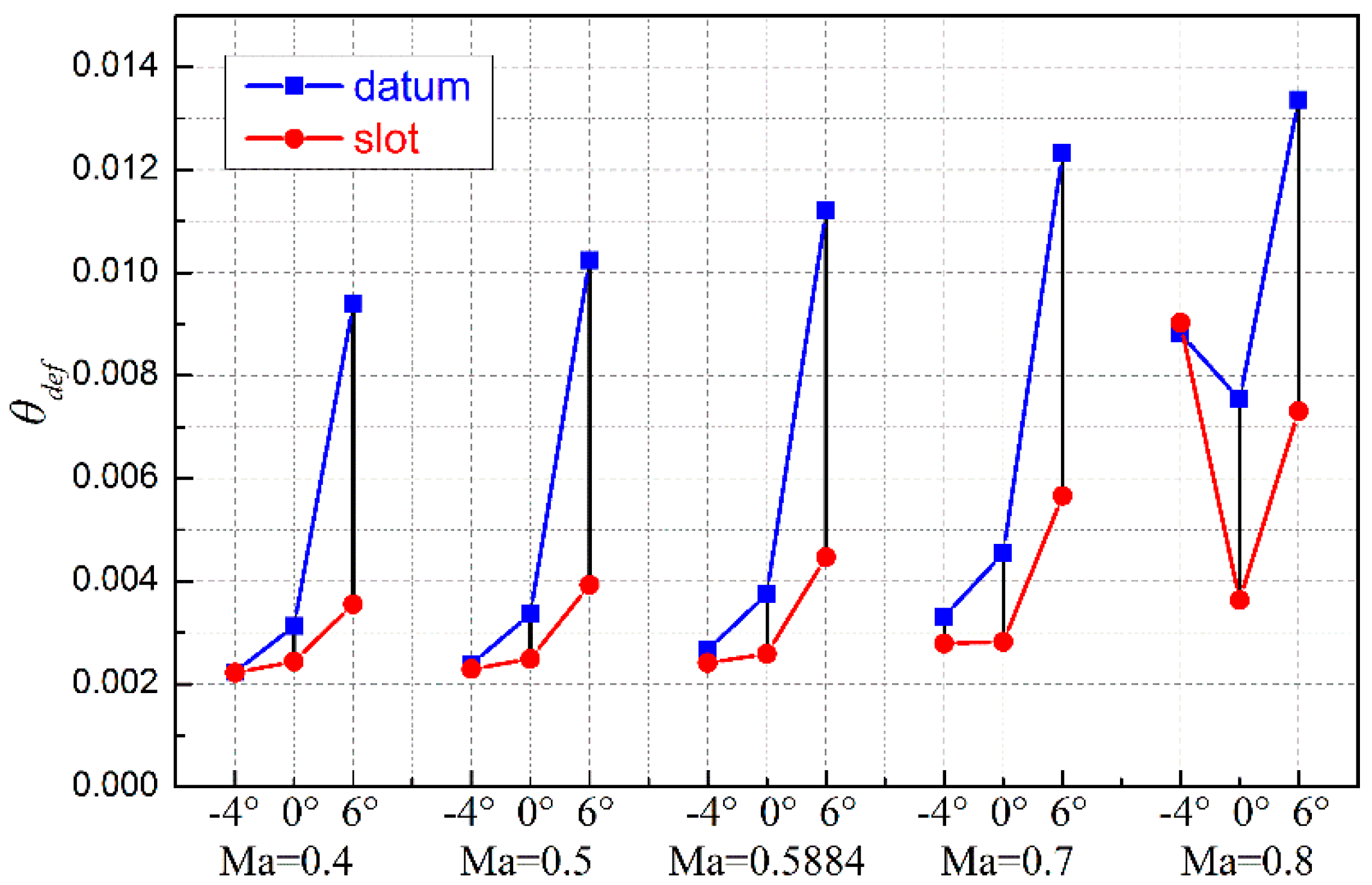

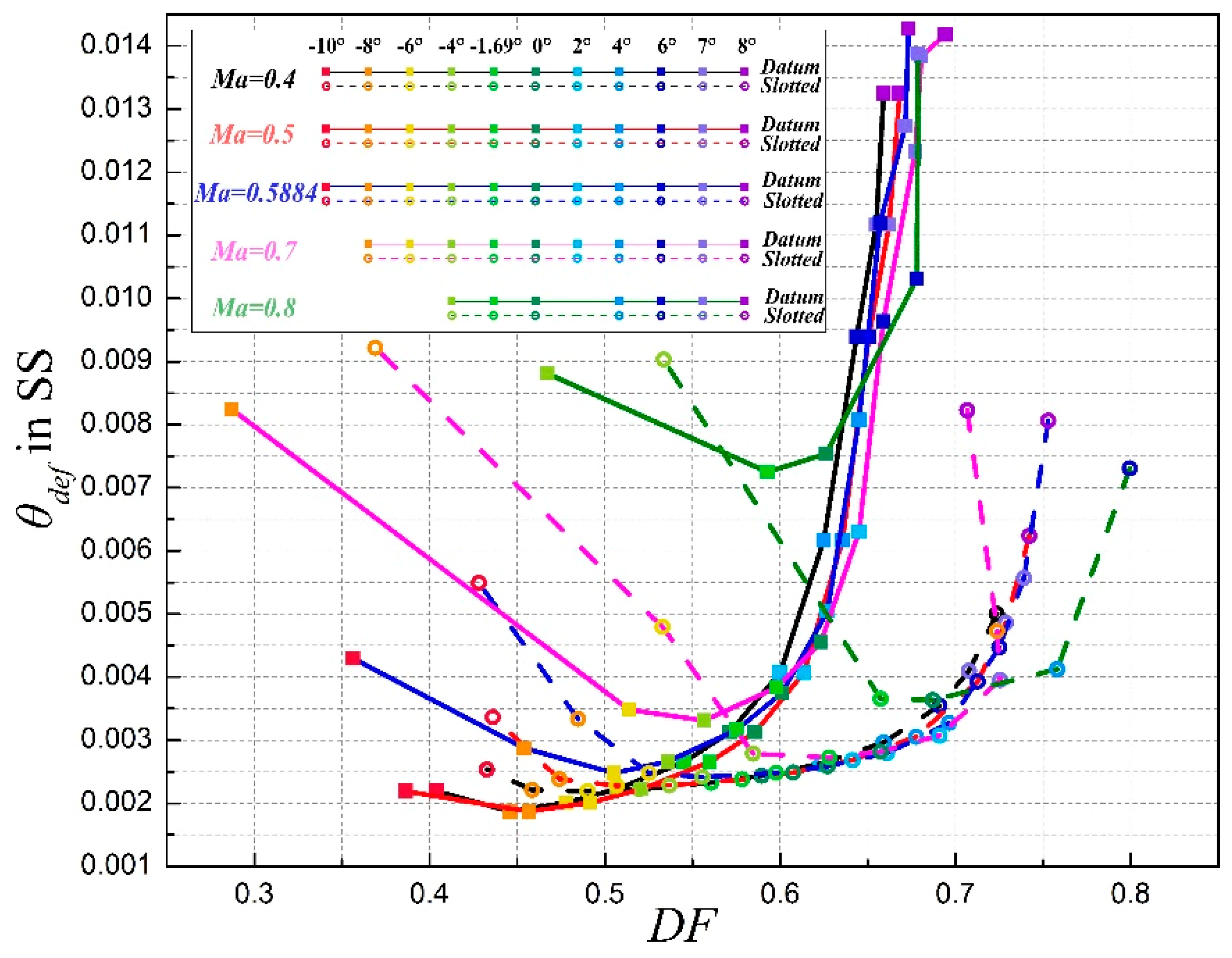
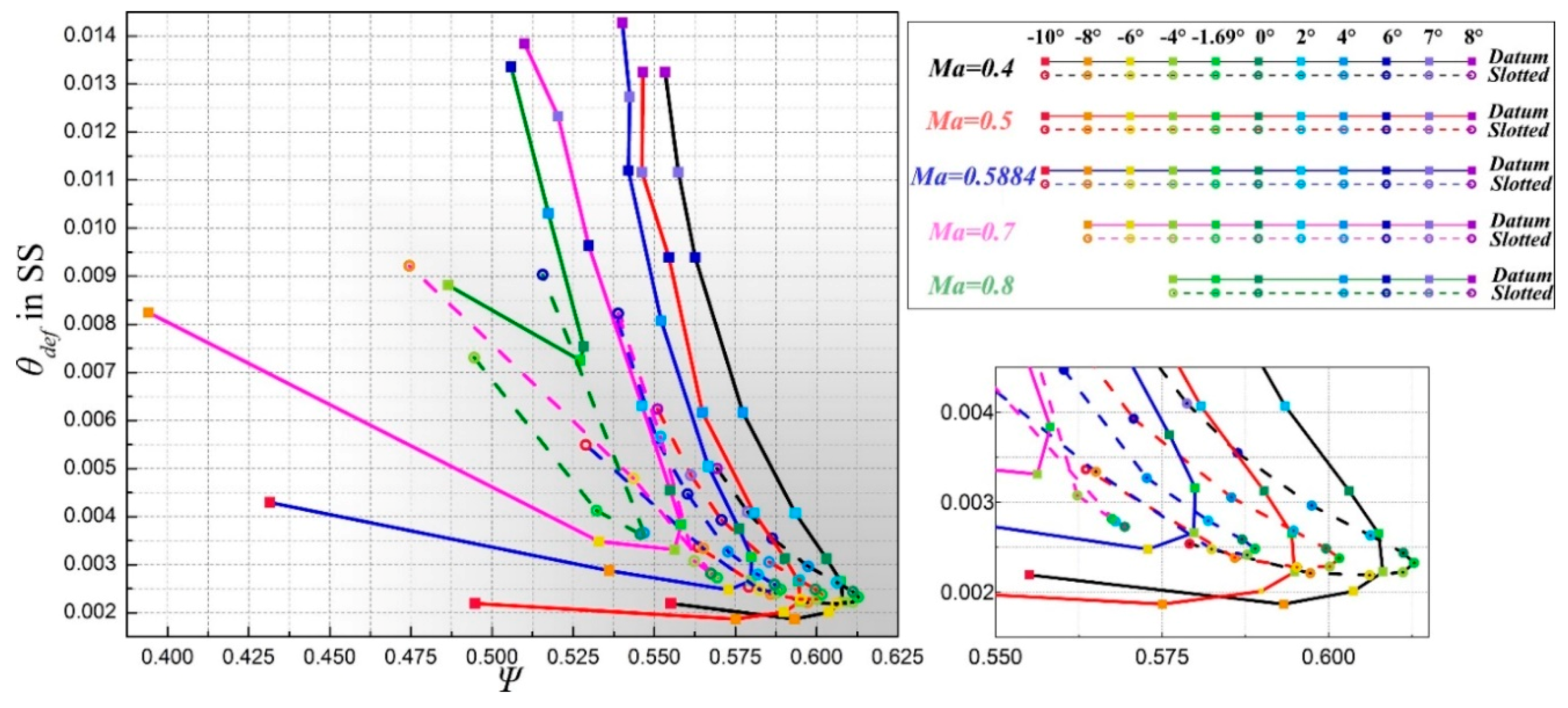
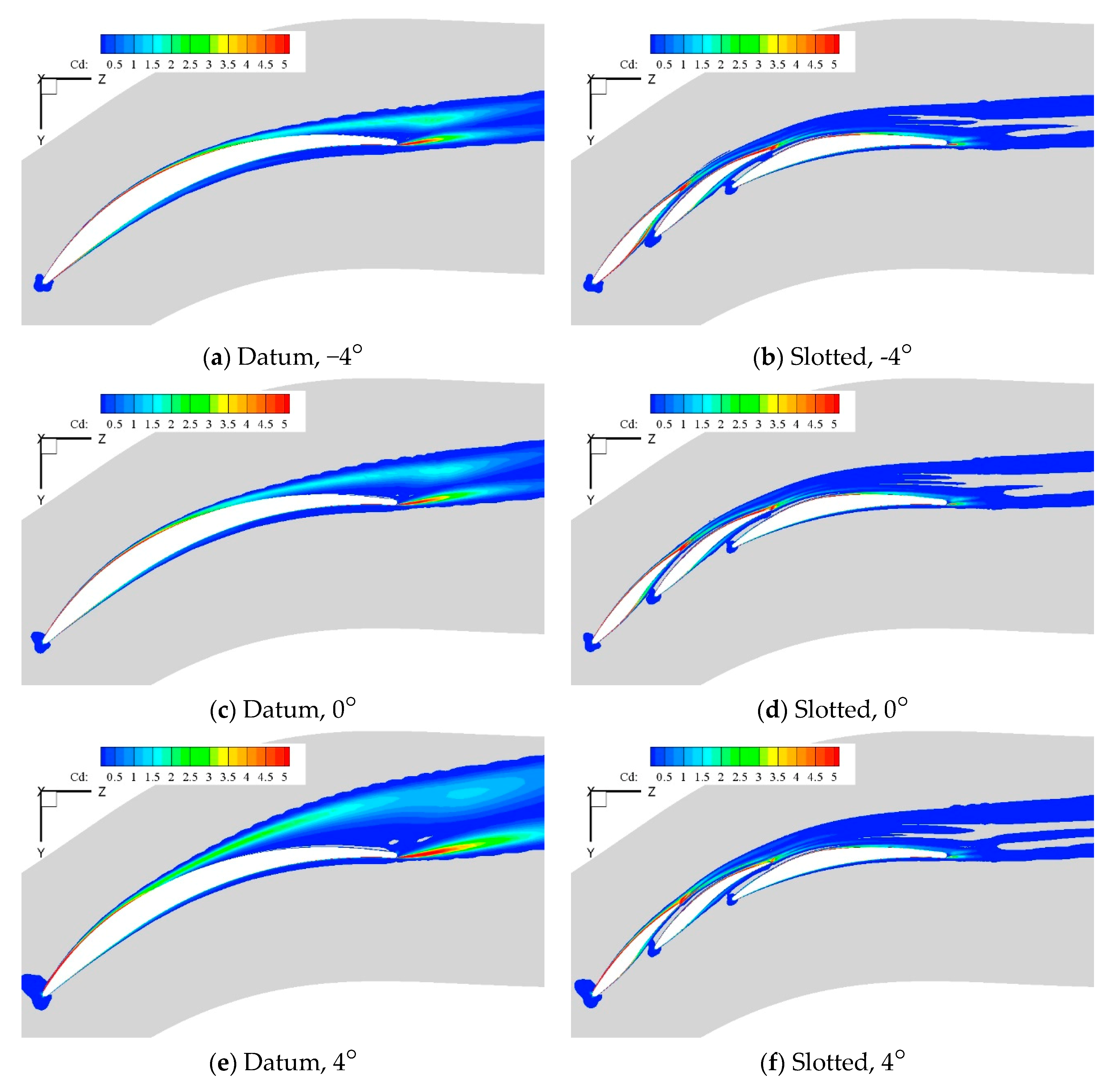
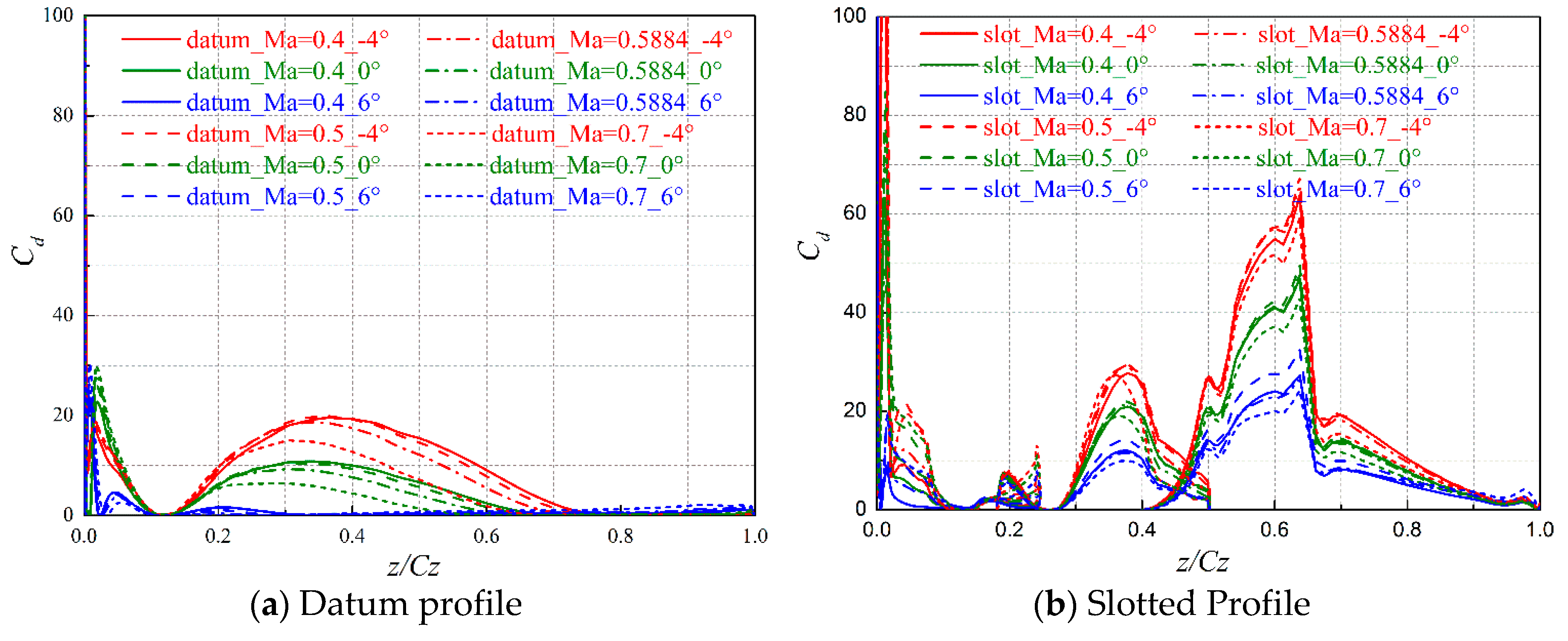


| Parameter | Value | Parameter | Value |
|---|---|---|---|
| Chord/c (m) | 0.055 | Inlet Mental Angle (°) | 41.91 |
| Solidity | 1.52 | Outlet Mental Angle (°) | 94.85 |
| Chamber Angle (°) | 52.94 | Stagger Angle (°) | 21.7 |
© 2020 by the authors. Licensee MDPI, Basel, Switzerland. This article is an open access article distributed under the terms and conditions of the Creative Commons Attribution (CC BY) license (http://creativecommons.org/licenses/by/4.0/).
Share and Cite
Tang, Y.; Liu, Y. Aerodynamic Investigation of Datum and Slotted Blade Profiles under Different Mach Number Conditions. Energies 2020, 13, 1673. https://doi.org/10.3390/en13071673
Tang Y, Liu Y. Aerodynamic Investigation of Datum and Slotted Blade Profiles under Different Mach Number Conditions. Energies. 2020; 13(7):1673. https://doi.org/10.3390/en13071673
Chicago/Turabian StyleTang, Yumeng, and Yangwei Liu. 2020. "Aerodynamic Investigation of Datum and Slotted Blade Profiles under Different Mach Number Conditions" Energies 13, no. 7: 1673. https://doi.org/10.3390/en13071673





